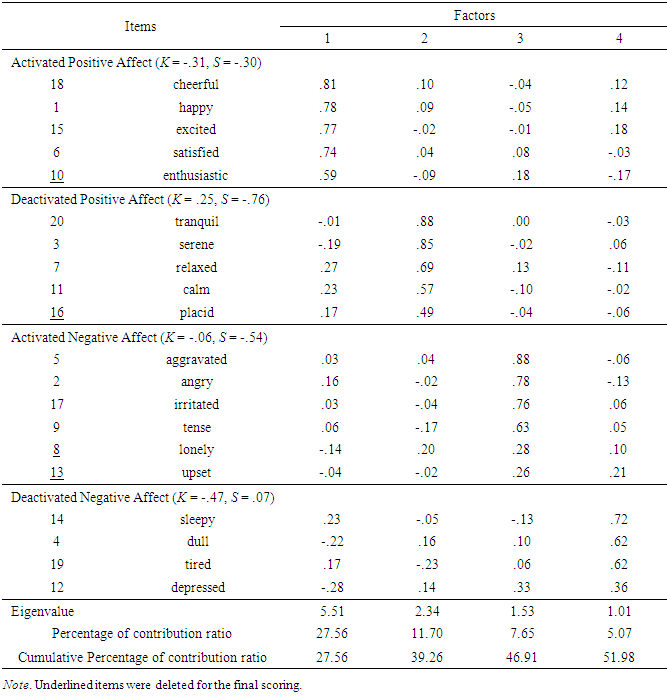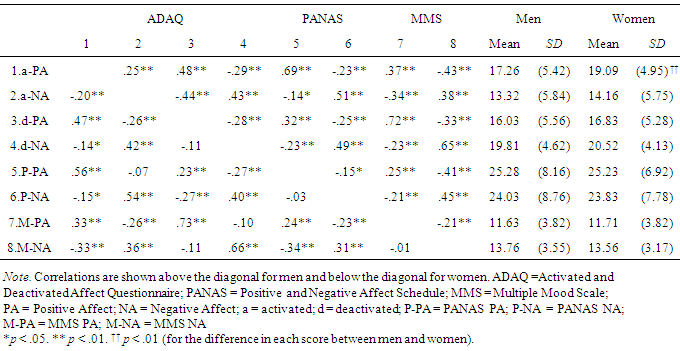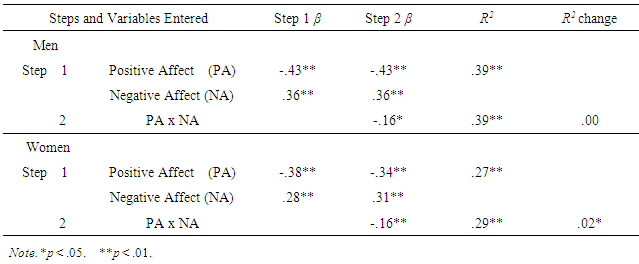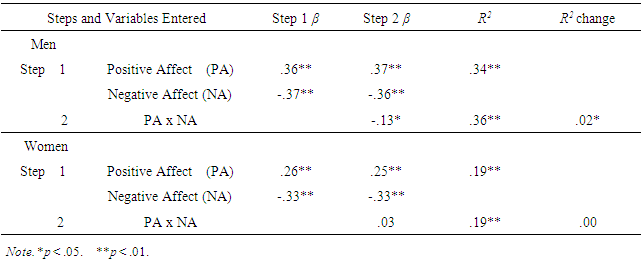-
Paper Information
- Paper Submission
-
Journal Information
- About This Journal
- Editorial Board
- Current Issue
- Archive
- Author Guidelines
- Contact Us
International Journal of Psychology and Behavioral Sciences
p-ISSN: 2163-1948 e-ISSN: 2163-1956
2016; 6(3): 139-147
doi:10.5923/j.ijpbs.20160603.07

Effects of Positive and Negative Affect on Depression: Considering the Activation Dimension and Balance of Affect
Katsuyuki Yamasaki, Kanako Uchida
Department of Human Development, Naruto University of Education, Tokushima, Japan
Correspondence to: Katsuyuki Yamasaki, Department of Human Development, Naruto University of Education, Tokushima, Japan.
| Email: |  |
Copyright © 2016 Scientific & Academic Publishing. All Rights Reserved.
This work is licensed under the Creative Commons Attribution International License (CC BY).
http://creativecommons.org/licenses/by/4.0/

According to the two-factor model of affect, affect consists of two dimensions, valence and activation, which allow us to consider different types of positive affect (PA) and negative affect (NA), i.e., activated PA (e.g., enthusiastic, happy), deactivated PA (e.g., calm, satisfied), activated NA (e.g., nervous, angry), and deactivated NA (e.g., sluggish, sad). The purpose of this study was to examine the relationship between affect and depression or short-term life satisfaction (LS) taking into account the dimensions of activation and balance of PA and NA. The study included 496 students (240 men and 256 women) who completed seven questionnaires, two of which were used for another study. The Activated and Deactivated Affect Questionnaire (ADAQ) was utilized for assessing activated and deactivated PA and NA, the Center for Epidemiologic Studies Depression Scale for measuring depression, and the Short-term Life Satisfaction Scale for gauging short-term life satisfaction. Two more questionnaires were used to test the concurrent validity of the ADAQ. Correlation analyses showed that depression and short-term LS exhibited negative and positive associations with affect balance (PA – NA), respectively, in both activated and deactivated dimensions. Additionally, hierarchical multiple regression analyses revealed a few significant interactive effects between PA and NA on depression and short-term life satisfaction. In regard to activated affect, activated PA was more negatively associated with depression when activated NA was higher in women, while activated PA was more positively associated with short-term life satisfaction when activated NA was lower in both men and women. In terms of deactivated affect, deactivated PA was more positively associated with short-term life satisfaction when deactivated NA was lower only for men. These findings are discussed in terms of the necessity to consider the activation dimension and the relationships between PA and NA in healthcare, along with some limitations of the study.
Keywords: Positive affect, Negative affect, Affect balance, Affect activation, Depression
Cite this paper: Katsuyuki Yamasaki, Kanako Uchida, Effects of Positive and Negative Affect on Depression: Considering the Activation Dimension and Balance of Affect, International Journal of Psychology and Behavioral Sciences, Vol. 6 No. 3, 2016, pp. 139-147. doi: 10.5923/j.ijpbs.20160603.07.
Article Outline
1. Introduction
- In recent years, relationships between affect (or emotions) and health (or adjustment) have been topics of intense research in the domains of health psychology and behavioral medicine. Emotions are concrete feelings such as angry and happy, while affect is defined in terms of the dimensions of activation and valence as stated below. Although the detrimental influences of negative affect (NA) on health are well known, an increasing number of studies have revealed that positive affect (PA) plays a crucial and beneficial role in health (see Pressman & Cohen, 2005, for a review). Phenomena relating affect and health have recently been scrutinized by examining the relationship between PA and NA. For example, the interaction and balance between PA and NA have been shown to be important to health. Since PA and NA are not contrary concepts and display null or low correlations (e.g., Pettit, Kline, Gencoz, Gencoz, & Joiner, 2001; Watson, Clark, & Tellegen, 1988), their relative contributions to health deserve examination. Previously, significant interactions between PA and NA were found to influence many health-related outcomes, such as well-being (Cheng, 2006), job performance (Van Yperen, 2003), and breast cancer concerns (Han, Shaw, Hawkins, Pingree, McTavish, & Gustafson, 2008). Cheng (2006) showed that the enhancing effect of PA on well-being appraisal became stronger when NA was higher. Han et al. (2008) found a tempering effect between writing positive emotion words and breast cancer concerns among those who wrote a higher percentage of negative emotion words. Similarly, Van Yperen (2003) found that the enhancing effect of PA on job performance was significant only when NA was high. Meanwhile, the effects of affect balance have been investigated in cross-cultural research. For example, Schimmack, Radhakrishnan, Oishi, Dzokoto, and Ahadi (2002) found that affect balance (as represented by the difference score of PA minus NA) was a stronger predictor of life satisfaction in individualistic cultures versus collectivistic ones. Suh, Diener, Oishi, and Triandis (1998) showed that correlations of affect balance with life satisfaction varied across nations, although the relationship was significantly positive in all cases. Thus, it is likely that PA and NA produce not only main effects on health and adjustment but interactive effects as well. Investigations into the effects of affect balance and interactions on health also need to consider another dimension of affect termed “activation.” According to the two-factor model of affect, the first unrotated factor is interpreted as a Valence dimension and the second unrotated factor as an Activation or Arousal dimension (Larsen & Diener, 1992; Russell, 1980). Thus, PA and NA, which represent the opposite ends of the Valence dimension, also change in the Activation dimension, which allows us to consider different types of PA and NA, i.e., activated PA (e.g., enthusiastic, happy), deactivated PA (e.g., calm, satisfied), activated NA (e.g., nervous, angry), and deactivated NA (e.g., sluggish, sad). It should be noted that the PANAS (Positive and Negative Affect Schedule; Watson et al., 1988), one of the most frequently used questionnaires, measures only activated PA and NA. In recent years, a few studies have begun to discriminate the two types of affect along the activation axis (e.g., De Dreu, Baas, & Nijstad, 2008; Nezlek & Kuppens, 2008; Tsai, Knutson, & Fung, 2006), and these reports suggest distinct roles for activated and deactivated affect. For example, Nezlek and Kuppens (2008) showed that the suppression of negative emotions was negatively associated with deactivated but not activated NA. De Dreu et al. (2008) revealed that activating moods (i.e., activated PA and NA) lead to more creative fluency and originality compared to deactivating moods (i.e., deactivated PA and NA). In research on cultural variations in affect valuation, Tsai et al. (2006) found that European American and Asian American individuals valued high-arousal PA more so than Hong Kong Chinese, while Hong Kong Chinese and Asian American individuals valued low-arousal PA more so than European Americans. These findings would not have been discovered if measures of PA and NA had not been divided and recorded along the activation axis. With respect to health and adjustment, differential effects of activated and deactivated affect are plausible. Likewise, the effects of affect balance and interaction on health and adjustment could be different between activated and deactivated affect dimensions. However, to the authors’ knowledge, no prior research has focused on these differentiations, which prevents us from building hypotheses on them. Spielberger & Reheiser (2009) underscored to examine emotions in terms of the experience, expression, and control each of which influences human health and well-being. By considering both dimensions of activation and valence, the current study will be helpful to more precisely examine emotional experience, which is associated with the following expression and control of emotions, than before. Thus, the aim of the present study was to examine the effects of affect balance and interaction on health and adjustment. In doing so, we considered both activated and deactivated PA and NA. Moreover, we focused on short-term life satisfaction as a health/adjustment outcome. Investigations into health problems in non-clinical samples require measures sensitive to preconditions that could lead to future disease. One of those candidate measures is life satisfaction, which is a conscious cognitive judgment of one’s past whole life in which the criteria for judgment are up to the individual (Pavot & Diener, 1993). Since “life” in life satisfaction does not need to be limited to the past whole life, we assessed it for the past week, which would represent a more sensitive measure of short-term life satisfaction.
2. Method
2.1. Participants and Procedures
- In addition to incomplete data from 107 participants, the ages of three participants constituted outlying data (over seven SDs from the mean age). These data were therefore excluded, such that the final sample included data collected from 496 undergraduate and graduate students (240 men and 256 women). The mean ages and SDs for this sample were 20.97 ± 2.56 yrs for men and 20.49 ± 3.89 yrs for women. Participants answered a battery of seven questionnaires, two of which were used for another study. All of the questionnaires were Japanese versions, answered in terms of experiences over the past week.Each participant gave written informed consent. After completing the questionnaires, the purpose of the study was explained to participants in detail.
2.2. Measures
2.2.1. Activated and Deactivated PA and NA
- The Activated and Deactivated Affect Questionnaire (ADAQ; Yamasaki, Sasaki, Uchida, & Katsuma, 2011) was utilized for assessing activated and deactivated PA and NA. The ADAQ is an original self-report questionnaire that includes 20 items, answered on a 7-point Likert-type format (“never true” to “very true”). Participants were asked to rate how they experienced each emotion during the past week. Although the ADAQ was developed referring to many prior scales (e.g., Gregg & Shepherd, 2009; Kuppen, Realo, & Diener, 2008; Nezlek & Kuppens, 2008; Terracciano, McCrae, Hagemann, & Costa, 2003; Van Katwyk, Fox, Spector, & Kelloway, 2000), the final question items were entirely tailored for Japanese adults. Item examples include “cheerful” and “happy” for activated PA, “tranquil” and “serene” for deactivated PA, “angry” and “irritated” for activated NA, and “sleepy” and “tired” for deactivated NA. The items were developed having their content validities checked by two psychologists with PhDs who were familiar with this research domain. Since the ds and validity of the ADAQ were not checked sufficiently in Yamasaki et al. (2011), we determined these dimensions in this study. We considered that if the scale was reliable and valid, we could then utilize it for scoring activated and deactivated PA and NA. In this case, the ADAQ could measure these two affect types (PA and NA) along a single scale, making it more accurate to compare different types of affect compared to using different measures.
2.2.2. Activated PA and NA
- Activated PA and NA were measured using the Japanese version of the Positive and Negative Affect Schedule (PANAS) (Sato & Yasuda, 2001). This scale was utilized to check the concurrent validity of the subscales of activated PA and NA in the ADAQ. The Cronbach’s alphas for PA and NA were both .85 in this study. The construct validity of these scales was established by a study in which PA, NA, and neutral affect were experimentally manipulated (Sato & Yasuda, 2001). Unlike the original version (Watson et al., 1988), the Japanese version contains eight items for both PA (e.g., enthusiastic, proud, and excited) and NA (e.g., afraid, jittery, and scared), which are rated on a 6-point Likert scale (from “not at all” to “extremely”). Thus, scores on the PA and NA scales each ranged from 8 through 48. In this study, participants were instructed to indicate the extent to which each item represented the way they felt over the prior one-week period.
2.2.3. Deactivated PA and NA
- Deactivated PA and NA were measured using the subscales of deactivated pleasure and boredom (respectively) from the Multiple Mood Scale (MMS; Terasaki, Kishimoto, & Koga, 1992). This scale was utilized to check the concurrent validity of the subscales of deactivated PA and NA in the ADAQ. Each subscale contains five items (e.g., relaxed, calm, and placid for PA; dull, tired, and bored for NA), rated on a 4-point Likert scale (from “never felt” to “clearly felt”) with score ranges of 5 through 20. In this study, participants were asked to rate how they experienced each emotion during the past week. The alphas were .88 and .76 for the PA and NA scales in this study, respectively. The concurrent validity of these subscales was established by Terasaki et al. (1992).
2.2.4. Depression
- The Japanese version of the CES-D (Center for Epidemiologic Studies Depression Scale; Shima, Shikano, Kitamura, & Asai, 1985), which was originally developed by Radloff (1977), was utilized to measure depression. The CES-D is a 20-item self-report scale inquiring about the participant’s experiences of negative mood states during the previous week. Each response is graded on a 4-point scale from 0 = “rarely or none of the time” to 3 = “most or all of the time.” Scores ranged from 0 to 60. Item samples include “I felt sad.” and “I felt depressed.” The alpha was .88 in this study. Shima et al. (1985) demonstrated the reliability of CES-D using correlations by test-retest and split-halves methods, and demonstrated validity by comparing scores between normal participants and depressed patients.
2.2.5. Short-Term Life Satisfaction (LS)
- LS was assessed by means of the Short-term Life Satisfaction Scale (SLSS), which was developed based on the Satisfaction with Life Scale (SWLS; Pavot & Diener, 1993). Although the SLSS includes similar instructions and contains five items similar to the SWLS, these elements were revised to allow for asking about the past week instead of the past whole life. Participants answered the five items pertaining to life during the past week on a 7-point Likert scale ranging from 1 (strongly disagree) to 7 (strongly agree). Item examples include: “If I could relive the past week again, I would change almost nothing.” and “I am satisfied with my life.” Total scores ranged from 5 to 35. The alpha was .87 in this study. The original U.S. version of the scale has high reliability and both convergent and discriminant validity (Pavot & Diener, 1993).
3. Results
3.1. Internal Consistency and Validity of the Activated and Deactivated Affect Questionnaire (ADAQ)
- All data analyses were conducted by gender because previous research has found gender differences in emotions (e.g., Crawford & Henry, 2004; Kring & Gordon, 1998). First, utilizing the total sample, a correlation matrix of the 20 items was subjected to factor analytic procedures using the principal factor method with promax rotation. Since the eigenvalues of the first four factors were above 1.0, these four were utilized for the promax rotation. Consequently, from the magnitude of the factor loadings and the content of items, these four factors were termed activated PA and NA and deactivated PA and NA, respectively (see Table 1). Four items in each factor (subscale) were determined to be the same between men and women. Thus, the number of the items in each subscale was identical and all of the factor loadings in the subscales were greater than .35. Next, the same analyses were conducted by gender, which revealed that the patterns of the factor loadings were slightly different between men and women. However, since the difference was small, the same four-item structure was adopted for both men and women according to the pattern of the factor loadings in the total sample. Alphas for activated and deactivated PA and NA were .87, .86, .83, and .70 for men and .85, .85, .84, and .70 for women, respectively. Additionally, since the kurtosis and skewness were not far from zero, it seems likely that the score distributions of the subscales represent normal distributions. Scores on each subscale ranged from 4 through 28.
|
|
3.2. Relationships among Affect and Health Outcomes
- In Table 3, correlations between all measures are shown with means and standard deviations for men and women, respectively. Since this study focuses on the effects of affect balance, see Yamasaki and Uchida (2014) for effects of affect per se. Significant correlations demonstrated that for both men and women, depression was negatively associated with activated and deactivated affect balance, while short-term LS was positively associated with both affect balances. The absolute magnitudes of these correlations were similar between activated and deactivated affect balance and between depression and short-term LS. No significant sex differences were found in any measures. These findings suggest that higher PA and lower NA are associated with lower depression and higher short-term LS, regardless of activated or deactivated affect.
|
|
|
 | Figure 1. Scores on depression as a function of activated positive and negative affect in women |
|
|
 | Figure 2. Scores on short-term life satisfaction as a function of activated positive and negative affect in men |
 | Figure 3. Scores on short-term life satisfaction as a function of activated positive and negative affect in women |
 | Figure 4. Scores on short-term life satisfaction as a function of deactivated positive and negative affect in men |
4. Discussion
- The current study focused on the relationship between affect balance/interaction and depression or short-term LS taking into account the dimension of affect activation. Also in this study, we confirmed the internal consistency and validity of a newly developed questionnaire (ADAQ) that can simultaneously assess four types of affect, i.e., activated and deactivated PA and NA. Correlational analyses showed that depression and short-term LS were negatively and positively associated with affect balance (PA-NA), respectively, for both men and women, regardless of activated and deactivated characteristics of affect. Moreover, hierarchical regression analyses on depression revealed that although activated PA was negatively associated with depression in women, the association was stronger when activated NA was higher. Regarding short-term LS, hierarchical regression analyses showed that although activated PA was positively associated with short-term LS, the association was stronger with higher activated NA in both men and women. Deactivated PA showed similar results in terms of short-term LS only in men. Our findings suggest that affect balance per se exhibited consistent associations with depression and short-term LS regardless of the activation level of affect and sex. Since affect balance is expressed as PA - NA, this score is higher with higher PA and lower NA. Although the current study did not clarify which affect was more influential in increasing affect balance, these significant correlations between affect balance and depression or short-term LS suggest the necessity to simultaneously consider both PA and NA. Moreover, the present finding that activated PA and NA had a significant interactive effect on short-term LS in both men and women deserves note. The basis for the interaction was that although higher activated PA was associated with higher LS, this positive association was larger when NA was lower. This finding is inconsistent with some previous studies. For example, Cheng (2006) showed that the enhancing effect of PA on well-being appraisal is stronger when NA is higher, and Van Yeperen (2003) found similar effects on job performance. Comparatively, Yamasaki, Nagai, and Uchida (2007) showed that health status as measured using the General Health Questionnaire (Goldberg & Hiller, 1979) was improved more by PA when NA was lower, which is consistent with the present data. Since significant interactions between PA and NA were found in terms of activated affect in all of the above studies as well as in the current study, the causes of these other discrepancies remain unclear. In this study, a similar interaction effect was found in deactivated PA only in men. This finding regarding deactivated PA is not comparable to previous research that had not considered deactivated characteristics of affect in this topic. In line with this consideration, we need to consider another interaction between PA and NA in this study whereby activated PA was more negatively associated with depression when activated NA was higher. This finding in depression might suggest that we need to discriminate between unhealthy outcomes such as depression and healthy outcomes such as life satisfaction when considering the interactive effects between PA and NA. However, since the detailed methods (including specific measures used and participant types) are different among the present and previous studies, future research should carefully examine how methodological conditions influence results. Some limitations of the present research should be noted. First, the cross-sectional design used in this study should be replaced by longitudinal or prospective designs so that causal relations might be tested. Particularly in prospective designs, short-term LS might be a more effective endpoint compared to global extant LS since the former is more sensitive to current conditions. Second, the concept and classification of LS should be further scrutinized. Although LS represents a hot topic in recent research, it seems likely that this concept has ambiguous and multiple components. For instance, Kim and colleagues (Jang & Kim, 2009; Kim, 2004) introduced the concept of “implicit LS” in contrast to the predominant concept of LS that they termed “explicit LS”. Implicit LS is measured by assessing the strength of automatic associations of one’s life with positive- versus negative-related words (Kim, 2004). According to their theory, explicit LS reflects current situations and may not necessarily reveal individuals’ summed experiences throughout their life. In contrast, implicit LS is less influenced by current situations and may better reflect experiences in the past whole life. In this study, a state-like, short-term LS was measured. As such, LS would be influenced more by current situations, which was our goal in the present study. LS could have both trait-like and state-like characteristics, as many other psychological concepts do. Short-term LS is regarded as a measure that reflects the state component of LS. However, since no prior research has compared global (explicit) and short-term LS, the comparative examination of both types of LS represents an urgent research topic.Third, some of the small R2 change scores found in the current study suggests that the findings should be retested. Also, if the effects are small, its meanings in clinical settings would not deserve consideration. In line with this consideration, we need to carefully interpret the results regarding deactivated NA, because the alpha of the scale was not so high (.70), suggesting the necessity of improving the scale in future research. Finally, affect should be ecologically measured in longitudinal or prospective studies, e.g., by using experience-time sampling methods. Since affect is easily changed, repeated measurements would be needed to more accurately assess experiences of PA and NA. Finally, by directly evaluating and comparing these health measures in clinical samples or in individuals at high risk for health impairment, we should conduct longitudinal research to determine whether similar findings are consistently observed. If we find similar roles of activated/deactivated affect with these study designs, we could then move forward towards prevention or interventional research that might enhance or improve health and adjustment in practical settings.
ACKNOWLEDGEMENTS
- The authors are grateful to Dr. Megumi Sasaki for assistance in conducting this research.
 Abstract
Abstract Reference
Reference Full-Text PDF
Full-Text PDF Full-text HTML
Full-text HTML





